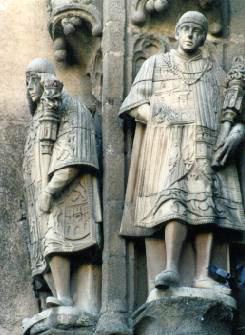 | ||
The Chronicler King of Arms in the Kingdoms of Spain was a civil servant who had the authority to grant armorial bearings. The office of the King of Arms in Spain originated from those of the heralds (Heraldos). In the early days of heraldry, anyone could bear arms and as is normal where human beings are involved there arose disputes between individuals and families. These disputes were originally settled by the King, in the case of a dispute between nobles or by a lower ranked official when the dispute involved non-nobles. Eventually, the task of settling these disputes was passed on to officials called heralds who were originally responsible for setting up tournaments and carrying messages from one noble to another.
The Spanish Cronista de Armas heraldic office dates back to the 16th century. But prior to that, heralds were usually named after provinces and non-capital cities, whilst reyes de armas were named after the Spanish kingdoms. Various chroniclers of arms were named for Spain, Castile, León, Frechas, Seville, Córdoba, Murcia, Granada (created in 1496 to honor the reunification of Spain), Estella, Viana, Navarre, Catalonia, Sicily, Aragon, Naples, Toledo, Valencia and Majorca. While these appointments were not hereditary, at least fifteen Spanish families produced more than one herald each in the past five hundred years (compared to about the same number for England, Scotland and Ireland collectively). The Spanish Cronistas had judicial powers in matters of noble titles. They also served as a registration office for pedigrees and grants of arms.
The post of King of Arms took several forms and eventually settled on a Corps of Chronicler King of Arms (Cuerpo de Cronista Rey de Armas) which was headed by an Elder or Dean (Decano). It usually consisted of four officers and two assistants or undersecretaries which usually acted as witnesses to documents. The entire corps wore a distinctive uniform. The corps were considered part of the royal household and was generally responsible to the Master of the King's stable (an important position in the Middle Ages).
Appointments to the Corps of King of Arms were made by the King or reigning Queen. These appointments were for life and while not intended to be hereditary, often went from father to son or other close family member. The Spanish heralds had other duties which pertained to matters of protocol and often acted as royal messengers and emissaries. They could, and can, make arrangements for areas currently or previously under the rule of the Spanish crown. The precise functions and duties of the King of Arms were clearly defined by the declarations of several Kings and are still in force today.
In modern times the Corps of Chronicler King of Arms went through several changes. Important changes were made in 1915, it was abolished in 1931 and restored in 1947–1951. The last Chronicler Kings of Arms appointed by the Spanish Ministry of Justice, Don Vicente de Cadenas y Vicent, died in 2005.
The government of the autonomous community of Castile and León has appointed Don Alfonso de Ceballos-Escalera y Gila, Marques de la Floresta as (Chronicler of Arms for Castile and León). Don Alfonso also serves as personal heraldic officer to the former King of Spain Juan Carlos I and the current King Felipe VI of Spain. Formerly, everything that the Spanish Heralds did had to be reviewed and approved by the Ministry of Justice for it to be valid. Legislation by Castile and León established the Chronicler King of Arms for Castile and León as the modern equivalent of the Spanish King of Arms.
Don Alfonso Ceballos-Escalera y Gila has appointed heraldic officers to support his efforts as Cronista Rey De Armas de Castilla y León. Pierre Daniel de Losada y Marti was appointed in 2014 as the Heraldo Magrigal, and Dr. Joseph MacNeal Crews in 2015 as the Persevante León Blanco.
